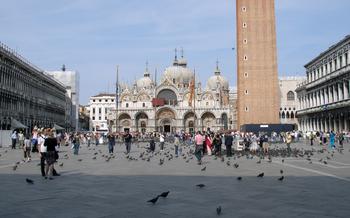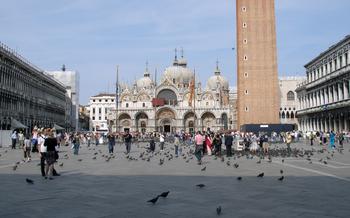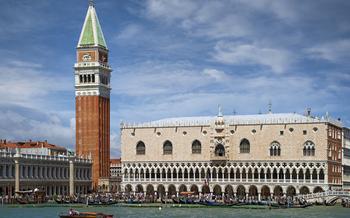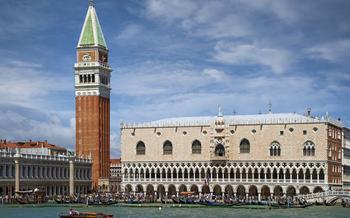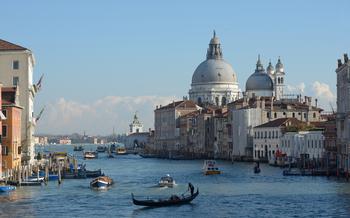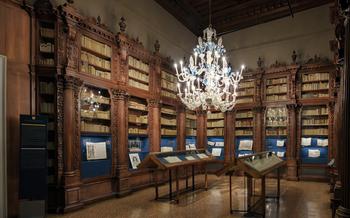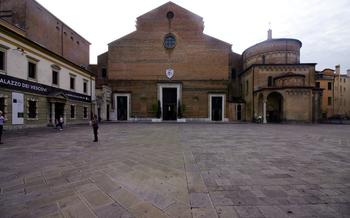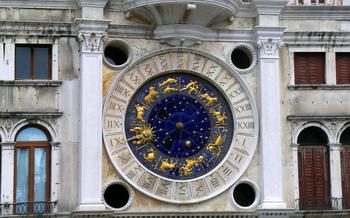
Doge's Palace Prisons
- Introduction
- Location
- History
- Architecture
- Exhibits
- Famous Prisoners
- Escapes
- Restoration
- Visiting the Prisons
- Hidden Gems
- Practical Tips
- Insider Tip
Introduction
The Doge's Palace Prisons, also known as the Pozzi or "Wells," were once the dark and dreaded dungeons of Venice, housing some of the most notorious criminals, political dissidents, and commoners who fell foul of the powerful Venetian Republic. Originally constructed in the 16th century to alleviate overcrowding in the main prison on the Riva degli Schiavoni, the Pozzi soon became a symbol of fear and oppression, their reputation as a place of suffering and death echoing throughout the centuries. Despite their grim history, the prisons offer a fascinating glimpse into the darker side of Venetian history and culture, inviting visitors to delve into the stories of those unfortunate souls who languished within their dank and oppressive walls.
Location
The Doge's Palace Prisons are situated in the heart of Venice, Italy, overlooking the picturesque St. Mark's Square. The exact address is Piazza San Marco, 1, 30124 Venezia VE.
In close proximity to the Doge's Palace Prisons, visitors can discover a multitude of other captivating attractions. The St. Mark's Basilica, with its awe-inspiring Byzantine architecture, stands just a stone's throw away. The Museo Correr, housing an extensive collection of Venetian art and artifacts, is also within easy reach. Moreover, the Torre dell'Orologio, with its intricate clock mechanism and stunning views of the city, is just a short stroll away.
History
The history of the Doge's Palace Prisons is intertwined with the rise and fall of the Venetian Republic. The palace itself was built in the 9th century as the residence of the Doge, the elected ruler of Venice. Over time, the palace became not only a symbol of Venetian power but also a place of incarceration for those who threatened the stability of the Republic.
The prisons were first used in the 12th century to hold political prisoners and those accused of crimes against the state. As Venice grew in power and influence, so did the number of prisoners held in the palace. By the 16th century, the prisons were overcrowded and unsanitary, and conditions for the prisoners were harsh.
The Doge's Palace Prisons played a crucial role in Venetian governance. The Doge and his council used the prisons to maintain their authority and to suppress dissent. The prisons were also used to hold prisoners of war and those accused of piracy.
In the 18th century, the Venetian Republic began to decline, and the prisons fell into disuse. In 1797, Napoleon Bonaparte conquered Venice, and the prisons were closed. The prisoners were released, and the palace was turned into a museum.
Architecture
The Doge's Palace Prisons are a complex of buildings located on the eastern side of the Doge's Palace. The oldest part of the prisons dates back to the 11th century, and the complex was expanded and modified over the centuries. The prisons consist of a series of interconnected buildings, including the Pozzi, the Piombi, and the Camerotti.
The Pozzi, or "wells," are a series of underground dungeons located below the water level. The Piombi, or "leads," are a series of cells located under the roof of the Doge's Palace. The Camerotti are a series of cells located on the upper floors of the palace.
The Pozzi are the most famous part of the Doge's Palace Prisons. They are a series of nine small, dark, and damp cells that were used to hold prisoners who were considered to be a threat to the state. The cells are located below the water level, and the prisoners were often kept in chains and forced to stand in water up to their ankles.
The Piombi are a series of cells that were used to hold prisoners who were considered to be less dangerous than those held in the Pozzi. The cells are located under the roof of the Doge's Palace, and they are hot and humid in the summer and cold and damp in the winter.
The Camerotti are a series of cells that were used to hold prisoners who were considered to be the least dangerous. The cells are located on the upper floors of the palace, and they are relatively comfortable compared to the other cells in the prison.
Exhibits
The Doge's Palace Prisons house a range of exhibits that offer a glimpse into the history of the prisons and the lives of those who were incarcerated within its walls. These exhibits include:
-
Documents and manuscripts: These documents provide insights into the laws and regulations governing the prisons, as well as the daily lives of the prisoners.
-
Prison cells: Visitors can explore the actual cells where prisoners were held, gaining a firsthand understanding of the harsh conditions they endured.
-
Torture instruments: The prisons display a collection of torture instruments that were used to extract confessions from prisoners. These instruments include whips, chains, and the rack.
-
Artwork: The prisons also feature a collection of artwork created by prisoners, which offers a unique perspective on their experiences. These works include paintings, drawings, and sculptures.
-
Personal belongings: The exhibits also include a collection of personal belongings that were confiscated from prisoners, such as clothing, jewelry, and letters. These items provide a glimpse into the lives of these individuals and the hardships they faced.
Famous Prisoners
The Doge's Palace Prisons have housed some of the most notorious criminals and political prisoners in Venetian history. One of the most famous prisoners was Giacomo Casanova, a renowned adventurer and womanizer. Casanova was imprisoned in 1755 for his involvement in a gambling scandal. He managed to escape from prison after 15 months, using a combination of charm, wit, and bribery.
Another famous prisoner was Count Cagliostro, an Italian alchemist and occultist. Cagliostro was imprisoned in 1789 for his alleged involvement in a counterfeiting scheme. He died in prison in 1795, after six years of solitary confinement.
Other notable prisoners included Marino Faliero, the Doge of Venice who was executed in 1355 for plotting to overthrow the government, the poet and playwright Torquato Tasso, who was imprisoned for seven years for his mental illness, and Giovanni Battista Tiepolo, one of the most celebrated painters of the 18th century, who was imprisoned for his debts.
The stories of these prisoners offer a glimpse into the dark side of Venetian history and the harsh realities of life in the Doge's Palace Prisons.
Escapes
The Doge's Palace Prisons witnessed several daring escape attempts, some successful and some not. One of the most famous escape attempts was that of Jacopo Foscari, the son of Doge Francesco Foscari. In 1457, Jacopo was imprisoned for treason and sentenced to exile. However, with the help of his father and a group of loyal friends, he managed to escape from prison and flee to Ferrara.
Another notable escape was that of Girolamo Cardano, a renowned mathematician and physician. In 1550, Cardano was arrested and accused of heresy. He was imprisoned in the Doge's Palace Prisons for several months, but he eventually managed to escape with the help of his wife.
Despite these successful escapes, most prisoners were not able to break free from the Doge's Palace Prisons. The guards were vigilant, and the prison's design made escape nearly impossible. However, the stories of these daring escape attempts add to the intrigue and fascination of the Doge's Palace Prisons.
Restoration
The Doge's Palace Prisons have undergone several restoration projects throughout history to preserve their historical significance and architectural integrity. The first major restoration took place in the 19th century when the prisons were converted into a museum. During this time, many of the original cells and features were restored, including the graffiti left by former prisoners.
In the 20th century, another major restoration project was undertaken to address the damage caused by water and neglect. This project involved extensive repairs to the prison buildings, including the restoration of the facades, roofs, and interiors.
More recently, in the 21st century, a comprehensive restoration project was completed to further enhance the visitor experience. This project included the installation of new lighting, signage, and interactive exhibits. The prisons were also made more accessible to visitors with disabilities.
Throughout the restoration process, great care was taken to preserve the historical authenticity of the prisons. Original materials and techniques were used whenever possible, and the goal was to maintain the original character of the site.
Thanks to these restoration efforts, the Doge's Palace Prisons have been preserved for future generations to appreciate and learn from. Visitors can now explore the prisons and gain a deeper understanding of their history, architecture, and significance.
Visiting the Prisons
The Doge's Palace Prisons are open to the public as part of the Doge's Palace Museum complex. Guided tours are available and highly recommended, as they provide a wealth of information about the history of the prisons and the lives of the prisoners. General admission tickets are also available, allowing visitors to explore the prisons at their own pace.
Guided tours typically last for about an hour and are available in various languages. They cover the history of the prisons, the different sections of the complex, and the stories of some of the famous prisoners who were held here. Visitors will also have the opportunity to see the cells where the prisoners were held, the torture chamber, and the execution chamber.
General admission tickets allow visitors to explore the prisons at their own pace. Visitors will receive a map and a guidebook to help them navigate the complex. Audio guides are also available for rent.
Prices and Available Discounts
Ticket prices for the Doge's Palace Prisons vary depending on the type of ticket and the time of year. Regular admission tickets for adults currently cost €200, while reduced tickets for students and seniors cost €20.00. Children under the age of 6 are admitted free of charge.
There are several ways to save money on admission to the Doge's Palace Prisons. Visitors can purchase a Doge's Palace Pass, which includes admission to the Doge's Palace, the Doge's Palace Prisons, and the Correr Museum. The pass is valid for 3 days and costs €30.00 for adults and €200 for students and seniors.
Visitors can also save money by purchasing tickets online in advance. Online tickets typically cost slightly less than tickets purchased at the door.
Finally, visitors can take advantage of free admission days. The Doge's Palace Prisons are free to visit on the first Sunday of every month.
Hidden Gems
Beyond the well-known attractions of the Doge's Palace Prisons, there lie hidden gems waiting to be discovered by curious explorers. One such treasure is the Pozzi, a series of underground cells where prisoners were held in solitary confinement. These cramped, dark, and damp chambers were a place of misery and despair, where prisoners were often left to languish for months or even years. Visitors can experience the eerie atmosphere of these cells by descending the narrow staircase that leads to their depths.
Another hidden gem is the Scala dei Giganti, a grand staircase that was once used by the Doge to make his ceremonial entrance into the palace. The staircase is adorned with statues of mythological giants, which were intended to symbolize the strength and power of the Venetian Republic. Visitors can admire the intricate details of the sculptures and imagine the Doge's procession as he ascended the staircase.
Practical Tips
-
When to Visit: Aim for the shoulder seasons (April-May and September-October) for pleasant weather and fewer crowds. The prisons are busiest in the summer (June-August), especially during cruise ship season.
-
Accessibility: The Doge's Palace is accessible to visitors with disabilities. There are ramps, elevators, and adapted toilet facilities available. Visitors should inform staff of any accessibility needs when booking their tickets.
-
Photography: Photography is allowed inside the Doge's Palace Prisons, but using flash photography is prohibited. Tripods are also not permitted.
-
Audio Guides: Audio guides and guided tours are available in various languages, providing informative commentary on the history and significance of the prisons.
-
Dress Code: Visitors should dress respectfully when visiting the Doge's Palace, covering their shoulders and knees. Shorts and tank tops are not appropriate attire.
Insider Tip
For a truly immersive experience, consider booking a night tour of the Doge's Palace Prisons. This exclusive tour offers a rare opportunity to explore the prisons in the eerie silence of the night. With the absence of daytime crowds, you can fully immerse yourself in the history and atmosphere of this fascinating place. The tour also includes access to restricted areas typically closed to the public, providing a glimpse into the hidden secrets of the prisons. Don't miss this chance to experience the Doge's Palace Prisons like never before.
